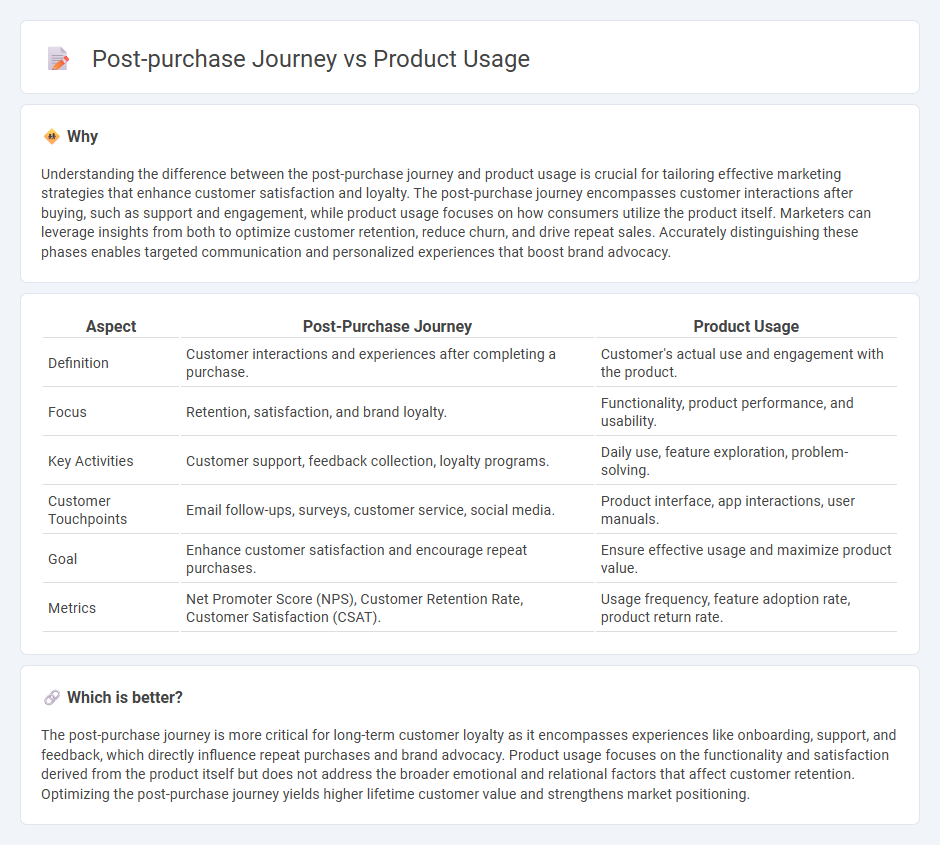
Post-purchase journey focuses on customer satisfaction and loyalty through support, feedback, and personalized communication, while product usage emphasizes seamless user experience and feature engagement to maximize value. Data-driven insights guide both strategies to enhance retention and drive repeat purchases. Discover how integrating these aspects can transform customer lifecycle management.
Why it is important
Understanding the difference between the post-purchase journey and product usage is crucial for tailoring effective marketing strategies that enhance customer satisfaction and loyalty. The post-purchase journey encompasses customer interactions after buying, such as support and engagement, while product usage focuses on how consumers utilize the product itself. Marketers can leverage insights from both to optimize customer retention, reduce churn, and drive repeat sales. Accurately distinguishing these phases enables targeted communication and personalized experiences that boost brand advocacy.
Comparison Table
| Aspect | Post-Purchase Journey | Product Usage |
|---|---|---|
| Definition | Customer interactions and experiences after completing a purchase. | Customer's actual use and engagement with the product. |
| Focus | Retention, satisfaction, and brand loyalty. | Functionality, product performance, and usability. |
| Key Activities | Customer support, feedback collection, loyalty programs. | Daily use, feature exploration, problem-solving. |
| Customer Touchpoints | Email follow-ups, surveys, customer service, social media. | Product interface, app interactions, user manuals. |
| Goal | Enhance customer satisfaction and encourage repeat purchases. | Ensure effective usage and maximize product value. |
| Metrics | Net Promoter Score (NPS), Customer Retention Rate, Customer Satisfaction (CSAT). | Usage frequency, feature adoption rate, product return rate. |
Which is better?
The post-purchase journey is more critical for long-term customer loyalty as it encompasses experiences like onboarding, support, and feedback, which directly influence repeat purchases and brand advocacy. Product usage focuses on the functionality and satisfaction derived from the product itself but does not address the broader emotional and relational factors that affect customer retention. Optimizing the post-purchase journey yields higher lifetime customer value and strengthens market positioning.
Connection
Post-purchase journey and product usage are interconnected through customer engagement and satisfaction metrics, which directly influence brand loyalty and repeat sales. Analyzing product usage data provides insights into customer preferences, enabling personalized marketing strategies that enhance the overall post-purchase experience. Effective management of this relationship increases customer lifetime value and drives sustainable business growth.
Key Terms
Customer Experience
The customer experience in the product usage phase influences satisfaction, loyalty, and long-term retention rates, with seamless onboarding, intuitive design, and effective support being critical touchpoints. Post-purchase journey management, including personalized follow-ups, proactive issue resolution, and engagement through loyalty programs, enhances brand perception and customer lifetime value. Explore effective strategies to optimize customer experience across product usage and post-purchase stages.
Product Adoption
Product adoption plays a crucial role in the post-purchase journey, determining how effectively users integrate a product into their daily lives and realize its full value. High adoption rates are linked to increased customer satisfaction, reduced churn, and enhanced brand loyalty. Explore best practices to optimize product adoption and elevate your post-purchase experience.
Customer Retention
Effective product usage drives customer retention by ensuring users derive maximum value and satisfaction from the offering, reducing churn rates. Seamless post-purchase experiences, including timely support, personalized communication, and loyalty programs, reinforce brand trust and encourage repeat engagement. Explore strategies to optimize the entire customer journey for sustained loyalty and growth.
Source and External Links
Product Usage: Definition, Examples, and Applications | LaunchNotes - Product usage refers to how consumers interact with a product, including the frequency, duration, and context of use, and is critical for product managers to understand user behavior and improve product development and marketing strategies.
What is Product Usage? | Signals & Stories - Mixpanel - Product usage analytics measures how often and how long users interact with a product, tracking metrics like usage frequency, time spent, bug reports, retention, and churn rate to influence customer satisfaction and product improvement.
Product Usage Metrics To Measure And Improve Product Engagement - Product usage is data showing when and how customers use a product, with metrics helping teams understand feature engagement, product performance, user activity, and guiding data-informed decisions to optimize product success.
 dowidth.com
dowidth.com